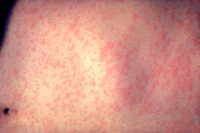Western medicine's terminology for the Flu is Influenza. It is an infectious disease caused by the Influenza viruses. Typically, influenza is transmitted through the air by coughs or sneezes, creating aerosols containing the virus. Influenza can also be transmitted by direct contact with bird droppings, nasal secretions, or by touching contaminated surfaces.
Approximately 33% of people with influenza do not even experience symptoms, yet they carry the virus. Influenza spreads around the world in seasonal epidemics, resulting in three to five million yearly cases of severe illness and about 250,000 to 500,000 yearly deaths. These cases increased to millions in some pandemic years. It can be difficult to distinguish between the common cold and influenza in the early stages of these infections. However, flu can be identified by a sudden onset of high fever/chills and extreme fatigue, with body temperatures ranging from 38-39 °C (approximately 100-103 °F). Many people are so ill that they are confined to bed for several days, with aches and pains throughout their bodies, typically worse in their backs and legs.
Symptoms of influenza may include:
- Fever and extreme coldness (chills shivering, shaking (rigor))
- Cough and/or Nasal congestion
- Body aches, especially joints and throat
- Fatigue
- Headache
- Irritated, watering and red eyes
- Reddened skin (especially face), mouth, throat and nose
- Petechial Rash (generally from excessive coughing or vomiting that causes broken capillary vessels)
- In children, gastrointestinal symptoms such as diarrhea and abdominal pain, (may be severe in children with influenza B)
COMPLICATIONS: Flu can occasionally lead to pneumonia, either direct viral pneumonia or secondary bacterial pneumonia, even for persons who are usually very healthy. Please note: it is a warning sign if a child (or adult) seems to be getting better and then relapses with a high fever as this relapse may be pneumonia. Another warning sign is if the person starts to have trouble breathing.
The flu vaccine is an option offered by the medical community, but studies show that more people acquire the flu from the vaccine than those who choose not to have it! Administration of the flu vaccine generates a lot of money, so you can imagine why the general public never hears about that. There are natural ways to counteract the flu that have definitely proven more effective than Tamiflu and far more than the toxic vaccine. I strongly discourage participation in the flu vaccine no matter what your age or stage of illness is.
PREVENTION: Assume all influenza, no matter what species it comes from, is contagious. The best prevention is to stay clear of it. But that is difficult since it spreads via aerosols and people can be carrying it and spreading it without actually showing signs of infection! Influenza viruses can be deactivated by sunlight, disinfectants and detergents, although soap and water are quite effective. Clean surfaces with 3% hydrogen peroxide and keep sneezes and coughs covered to prevent sharing your virus. Wash hands often and maintain good hygiene.
TREATMENT: The Flu Relief Remedy is designed to help control the fever, cough and other symptoms common with the flu. Providing Support for the Sinus and Lungs increases the body's ability to fight off the germs, allowing your body's own defenses to work better. The Influenza Detox contains a homeopathic-style detox for every single one of the Influenza strains, all those known to infect humans AS WELL as those not thought to infect humans. That means there is a Detox for the entire Orthomyxovirus collective and it addresses antigenic drift (evolved mutations of the viruses).
If you need additional help, purchase the MMS. Colloidal silver is also a known effective anti-viral. The most effective version, in my opinion, is Silver Shield made by Nature's Sunshine company, specifically because of the 10,000 volts used in the process of making this particular silver formula.
 Human respiratory syncytial virus (RSV) is a virus that causes respiratory tract infections. It is the major cause of lower respiratory tract infections and results in many hospital visits during infancy and childhood.
Human respiratory syncytial virus (RSV) is a virus that causes respiratory tract infections. It is the major cause of lower respiratory tract infections and results in many hospital visits during infancy and childhood.
 Rabies is a viral disease that causes acute encephalitis (inflammation of the brain). It is zoonotic (i.e., transmitted by beasts), most commonly by a bite from an infected subject. Roughly, ninety-seven percent of human rabies cases come from dog bites.
Rabies is a viral disease that causes acute encephalitis (inflammation of the brain). It is zoonotic (i.e., transmitted by beasts), most commonly by a bite from an infected subject. Roughly, ninety-seven percent of human rabies cases come from dog bites. The B19 virus, generally referred to as parvovirus B19 or sometimes erythrovirus B19, causes a childhood rash called fifth disease or erythema infectiosum, which is commonly called "slapped cheek syndrome". You can see why by the photo. The virus is primarily spread by infected respiratory droplets, but blood-borne transmission has been reported.
The B19 virus, generally referred to as parvovirus B19 or sometimes erythrovirus B19, causes a childhood rash called fifth disease or erythema infectiosum, which is commonly called "slapped cheek syndrome". You can see why by the photo. The virus is primarily spread by infected respiratory droplets, but blood-borne transmission has been reported. Fifth disease is also known for "lace-like" rashes on the arms, legs, torso, and back. These rashes can last for up to 5 weeks and are worse after sun exposure, exercise, or hot baths.
Fifth disease is also known for "lace-like" rashes on the arms, legs, torso, and back. These rashes can last for up to 5 weeks and are worse after sun exposure, exercise, or hot baths. HPIVs (human parainfluenza viruses) are spread person to person by direct contact with infected secretions through respiratory droplets or contaminated surfaces or objects. Infection can occur when infectious material contacts mucous membranes of the eyes, mouth, or nose, and possibly through the inhalation of droplets generated by a sneeze or cough. HPIVs can remain infectious in airborne droplets for over an hour. HPIVs are ubiquitous and infect most people during childhood. The highest rates of serious HPIV illnesses occur among young children. Serologic surveys have shown that 90-100% of children aged 5 years and older have antibodies to HPIV-3, and about 75% have antibodies to HPIV-1 and -2.
HPIVs (human parainfluenza viruses) are spread person to person by direct contact with infected secretions through respiratory droplets or contaminated surfaces or objects. Infection can occur when infectious material contacts mucous membranes of the eyes, mouth, or nose, and possibly through the inhalation of droplets generated by a sneeze or cough. HPIVs can remain infectious in airborne droplets for over an hour. HPIVs are ubiquitous and infect most people during childhood. The highest rates of serious HPIV illnesses occur among young children. Serologic surveys have shown that 90-100% of children aged 5 years and older have antibodies to HPIV-3, and about 75% have antibodies to HPIV-1 and -2. Human papillomaviruses (HPV) establish productive infections either in keratinocytes of the skin (outermost layer of the skin, causing warts) or in mucous membranes, as in the case of HPV. HPV is the most frequent sexually transmitted disease in the world!
Human papillomaviruses (HPV) establish productive infections either in keratinocytes of the skin (outermost layer of the skin, causing warts) or in mucous membranes, as in the case of HPV. HPV is the most frequent sexually transmitted disease in the world!


